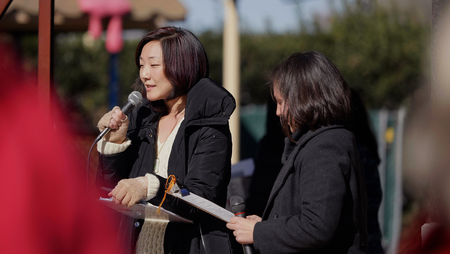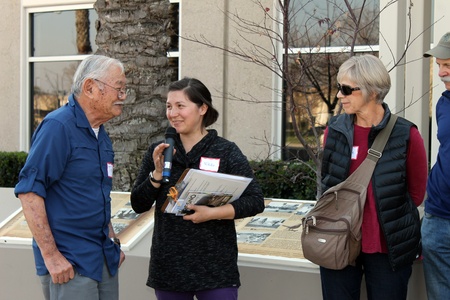For many Japanese American communities across the country, February 19 marks a Day of Remembrance. On that day seventy-seven years ago, in 1942, President Franklin Delano Roosevelt signed Executive Order 9066, turning the west coast of the United States into an active military zone and granting the secretary of war broad powers within those exclusionary zones.
A reaction to widespread anti-Japanese xenophobia in the wake of Pearl Harbor, Executive Order 9066 paved the way for the illegal incarceration of Japanese and Japanese Americans residing in those zones in concentration camps across the country, from Manzanar in California to Jerome in Arkansas. Today, February 19 marks a day to commemorate and reflect upon the grave injustice inflicted on the Japanese American community, and how its legacy continues to remain relevant to this very day.
It was at one such Day of Remembrance event in the California city of Fresno where childhood friends, Brynn Saito and Nikiko Masumoto, re-connected and the genesis of what would become the Yonsei Memory Project was born. Both women grew up in California’s agrarian Central Valley and met through the Japanese American church attended by their families.
Having followed each other’s careers as they grew older, the Day of Remembrance provided the impetus and inspiration for the Memory Project. As Yonsei, or fourth generation Japanese Americans, they each felt a “generational calling” with the realization that there’s would likely be the last generation to have intimate familial relationships with the Nisei, second generation, and Sansei, third generation, survivors of the camp incarceration. Each felt a deep sense of responsibility to keep alive those painful collective memories by lending their voices and energy to their communities. “We wanted to create spaces for inter-generational healing and sharing as well as new forms and modes of public education.” The Yonsei Memory Project is a place for individuals to tell their stories and add their, “own poetry and performance to the field of Japanese American memory work.”
Both Brynn’s and Nikiko’s families came to America around the turn of the 20th century. Each of Nikiko’s Japanese great-grand mothers hailed from Hiroshima and Kumamoto as picture brides, or Japanese women arranged to marry men abroad with little more than a picture and family recommendations for reference. Brynn’s family emigrated to America from both Japan and Korea, and one of her great-grand mothers was also a picture bride. During World War II, their families were sent to the Gila River concentration camp. Brynn’s Japanese grandparents were in their twenties when they were incarcerated. Nikiko’s “baachan” and “jiichan” were both in their teens at the time, with the later having been drafted to serve in the 442nd Infantry Regiment, a military regiment comprised almost entirely of second-generation Japanese Americans and the most decorated unit in the history of the U.S. military.
Most survivors of the camp experience remained reluctant to speak of their experiences for decades, the traumatization of their imprisonment having driven them to silence. In attempting to learn family history, many stories end up being, “passed down in silences or passing conversations with references to ‘camp.’” Much of this history for both of their families ends up being implied through elided references, stray photographs, or letters, and succeeding generations are left with the difficult task of trying to suss out those family histories. And when those memories come to the fore, they can often bring to mind past trauma, as Nikiko’s grandmother recalls when remembering how at thirteen years old she was spit on by a white classmate the day after Pearl Harbor. “At 91, she still shakes her head when she recalls this memory.”
Nikiko credits her father, author and nationally-recognized organic farmer David Mas Masumoto, with having, “given my generation a tremendous gift by keeping family heirlooms, documenting stories, and writing books that capture different experiences of being Japanese American and reflecting on World War II.”
Though recalling such memories can be painful, it can also offer a powerful catharsis and a bridge to a greater sense of understanding and empathy. The art of storytelling has influenced and permeated both women’s careers as way of exploring questions relating to family histories and memories. In turn, those connections frequently show up in their creative works. As a poet, Brynn weaves the landscape of the Central Valley into poetry work alongside, “profound moments of connection with her family members.” Likewise, Nikiko has been farming the same land plowed by her ancestors and those generational connections come to life through what she creates. “I nurture the same living plants that they planted. I see the changes in the environment and understand our tenuous relationship with balance and the challenges of the future.”
The diversity of their heritage has provided them with valuable perspectives on the experiences of their families and its place in history. As a descendant of not only Japanese but Korean immigrants to America, Brynn carries the collective memories of both groups with her. In addition to the memories of Japanese American incarceration that have been passed on, she is acutely aware of the troubled and fraught history between Japan and Korea. Many Korean Americans have recalled the brutal occupation of the peninsula by Japanese forces, and now she sees it as her duty to, “honor and know all of the cultures, people, and stories that shape me. And, to acknowledge the root forms of colonialism, racism, and fear that underpin the politics of occupation, detention, and separation across time and culture.”
Similarly, Nikiko’s Japanese American ancestry is joined to the German American experience on her mother’s side. She knows much less about the family history on her mother’s side, as “Whiteness makes cultural difference invisible for those who want entry, the immigrant history of my German family has been largely quieted.” The lack of such family historical knowledge throws her Japanese American background into sharp relief, and it’s, “been part of the pain of understanding my identity: that one set of my grandparents were imprisoned and the others stood by in silence.”
The Yonsei Memory Project is grounded in the recollection and telling of stories such as these. “Storytelling, like memory, is always at risk of dying,” and it is through the transmission between speaker and listener that those tales are kept alive for future generations. That exchange takes on added significance because it is deeply personal and affective, happening in the moment, “between bodies and souls.” When one takes into consideration the aging Japanese American population which lived through the experience of mass incarceration, the utilization of storytelling as a way to educate new generations on that history becomes more important than ever.
“The knowledge of Japanese American history is most poignant when it is knowledge and understanding that is felt… Storytelling activates sacred listening and plants a seed of truth in our hearts. It’s then up to us to nurture that seed.” This is particularly true in light of the current political climate, though Brynn and Nikiko seek the silver lining in what may at times seem to be a very dark cloud. “The gift of this time period is prophetic urgency and peaceful courage… we have dug deeper into our voices and have been even more tuned into the power of practicing and living the values and ideals we know will deliver us into a more just and loving world.”
* * * * *
Nikiko Masumoto will share insights from the Yonsei Project's three years of work in "Memory Crafting: How Do We Remember the Unspeakable, A Yonsei Perspective," a workshop at the Japanese American National Museum on Saturday, March 7, 2020. This workshop will invite attendees to immerse themselves in acts of memory and memory crafts. “Memory crafting” are activities, exercises, and ways of constructing gatherings that help transform facts and knowledge of history into practices of memory.
For more information and to RSVP, visit janm.org.
© 2020 Ian Hunter / Japanese American National Museum







